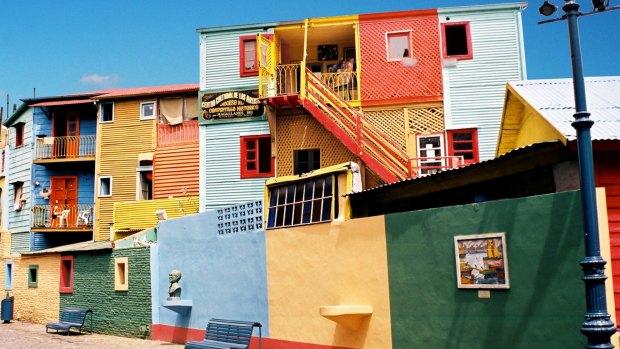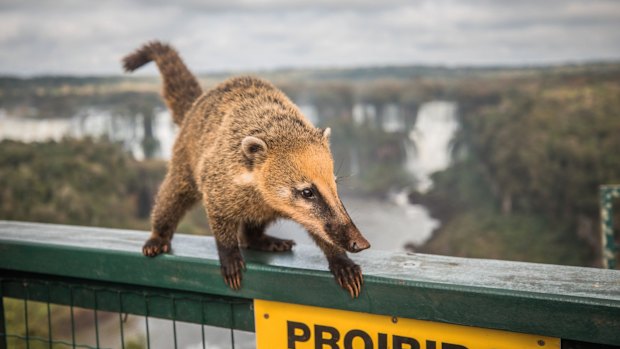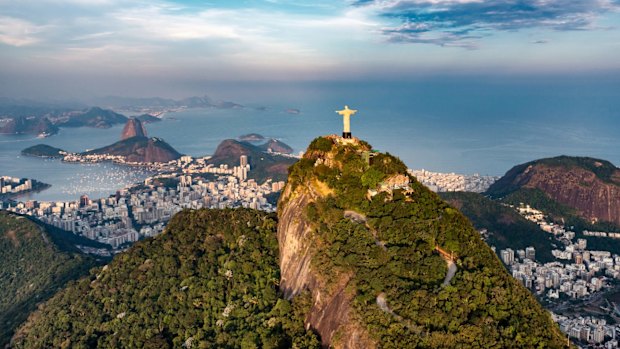This was published 4 years ago
South America: Tango, cowboys and beach culture add a sensual sizzle to this tour
By Kristie Kellahan

Colourful streetscape in Buenos Aires.Credit: Collette
"Let me tell you the story of the tango," says Andrea Fernandez. "It is a story of passion, of lust, of lovers torn apart."
OK, I'm listening. Fernandez, the tour manager on our Collette guided exploration of South America, is explaining the background of the world's sultriest dance as we make our way to La Ventana Tango House in the San Telmo neighbourhood of Buenos Aires.
It was in the brothels and bars of this formerly rough-and-tumble area that the tango is said to have originated more than 150 years ago, erupting from the pent-up passions of local workers, slaves and immigrants far from home.

Coatis at Iguazu Falls.Credit: Collette
Today, the tango is inextricably linked to fiery Argentine culture. In 2009, it was officially included on the UNESCO Intangible Cultural Heritage List. There's no better way to toast the first night of our 10-day guided tour than with a steak dinner, several glasses of malbec, and a performance that thrills and titillates in equal measure.
With three nights at the Sofitel Buenos Aires Recoleta Hotel, we have time to explore the city at a relaxed pace before taking a daytrip to a working horse ranch. After that we fly to Iguazu Falls to witness the spectacular sprays from both the Argentinian and Brazilian sides. Finally, a few nights in Rio de Janeiro to get into the Carnival spirit, sip caipirinhas on Copacabana Beach and visit the massive Christ the Redeemer statue.
It's a trip that neatly wraps up the highlights reel of South America, perfect for first-timers and those who prefer to travel in the safety of a well-organised group. Our travelling band of strangers is made up mainly of friendly, retired American schoolteachers, plus a few Brits and a family from the Philippines. There are several solo travellers, including myself, taking advantage of the camaraderie of group travel as well as the peace and quiet of a hotel room of one's own.

Aerial view of Rio De Janeiro. Credit: Stevica Mrdja
It's often been said that Buenos Aires is the most European of all South American cities. The Continental influence is most evident in the city's sophisticated architecture along the leafy Avenida 9 de Julio boulevard and around the mansion-lined streets of Recoleta.
One of the most beautiful bookstores in the world, El Ateneo Grand Splendid, started life a century ago as a lavish theatre. I admire the soaring ceilings and order a cup of tea at the cafe, located on what was once the stage. I make a mental note to book in advance next time for tickets to the national opera house, Teatro Colón, ranked one of the top 10 performance spaces in the world for its lush interiors and pitch-perfect acoustics.
On a walking tour, we pass by magnificent buildings constructed between the end of the 18th century and the beginning of the 20th, when Argentina's economic star was on the rise. By 1913, the nation's citizens were the 10th wealthiest in the world, per capita.
That ranking has slipped dramatically in the intervening years – 64th, at last count – as locals grapple with a failing economy and inflation that runs at close to 50 per cent each year. Tough times for many, though a bonus for visitors who will find their dollars stretching far. Shopping in the colourful San Telmo neighbourhood, fellow passengers spend up on leather goods, Pope-paraphernalia (Jorge Bergoglio, aka Pope France, hails from from Buenos Aires) and bottles of local wine.
We stop at Casa Rosada, the pink-hued presidential palace, wih its famous balcony from where presidents such as Juan Peron and his wife Eva stood to address supporters. The legend of "Evita" is everywhere in Buenos Aires, a controversial president's wife who divides opinion but has never been forgotten. Later, when we visit her final resting place at Recoleta Cemetery, we see many bouquets of red roses and candles have been left by fans.
From the bustle of Buenos Aires, it's a complete change of scenery as we head to the countryside for a day on the Argentine Pampas, South America's version of the Wild West. The village of San Antonio de Areco claims to be the birthplace of gaucho folklore, and the cowboy traditions live on here at rural estancias (ranches).
Dressed in denim jeans, plaid shirts and leather boots, young ranch hands serve up empanadas and a barbecue lunch, before switching to performance mode for a display of whip-cracking and traditional dancing.
Weathered old gauchos help gung-ho visitors into the saddle for a horseback ride, while most of us opt for the scenic carriage ride option. It's a big, fun day out and I hear more than a few telltale snores on the drive back to our city hotel.
For at least two members of our group – a retired geography teacher from Pennsylvania and a scientist from the UK – the real highlight of the tour comes the next day when we fly to Iguazu Falls. Wider than Zimbabwe's Victoria Falls, taller than Niagara and flowing with phenomenal force, the 275 waterfalls are a true bucket-list sight.
It's possible, indeed advisable, to take in the beauty of the falls from both the Argentinian and Brazilian sides in order to soak up all the views. That's just what we do, flying in on a Latam flight from Buenos Aires, then departing from the Brazilian side a couple of days later. We stay at a spa resort close by Iguazu National Park, spending our free time swimming in natural thermal pools, relaxing with spa treatments and enjoying a folklore show at the spot where the borders of Brazil, Argentina and Paraguay converge.
The falls, up close, are thunderous and spectacular. A boardwalk leads to the edge of Devil's Throat Falls, close enough to get wet from the thick clouds of mist. The sound of water crashing to the river below fills my ears. Later, we get even closer on a speedboat ride, copping a drenching from massive sprays of water. Some locals wear bikinis for the ride. I overhear an Argentinian man sniff that they must be Brazilians.
The next day, when we arrive in Rio de Janeiro, I understand what he means. Beach culture, and the body-confident sassiness that goes with it, is as much a part of Brazilian culture as Carnival and the Christ the Redeemer statue that benevolently watches over the coastal city from atop Corcovado mountain.
Even on an overcast afternoon, Copacabana Beach is abuzz with activity as locals work out, rollerblade, strut, flirt and drink icy "chopps" of beer from the bars that line the sand.
Carnival, the biggest party on the Brazilian calendar, lasts for six raucous days in February each year. For those who visit Rio outside this time, it's possible to have a taste of the glittering spectacle on a behind-the-scenes tour at one of the city's top samba schools. We do just that, touring the warehouse where the Pimpolhos of Grande Rio practise their moves year-round.
Hundreds of spectacular costumes are created there each year, a dizzying display of sequins, feathers and fluoro leotards that we are invited to try on in a hilarious exercise that proves Brazilians most definitely do it better.
On our last night in Rio, we enjoy a feast at a traditional churrascaria restaurant where caipirinhas flow like water. As the live band pumps out Latin favourites – The Girl from Ipanema lures several to the dance floor – handsome waiters weave between the tables. They carry skewers of delicious grilled meats – sirloin, short ribs, brisket, suckling pig, chicken legs – and cheerfully serve us until we finally say "stop" by flipping our coasters from the green to the red side.
It's a delicious, fun and tipsy way to farewell this South American adventure.
FIVE OF THE BEST THINGS TO EAT AND DRINK IN SOUTH AMERICA
Caipirinhas are the national drink of Brazil, a refreshing boozy mix of cachaca (the local spirit made from sugarcane), sugar and lime. Beach bars in Rio de Janeiro serve them icy cold.
Empanadas might just be the ultimate handheld snack. Stuffed with beef, chicken or cheese, the inexpensive pastries are everywhere in Buenos Aires.
You won't have any trouble finding a good steakhouse in Argentina – it's paradise for meat-lovers. Don Julio in Palermo is one of the most popular.
South American malbec grapes get the most attention in the red-wine-drinking world, but take the opportunity to try the lesser-known tannats and tempranillos.
Chimichurri is made from parsley, garlic, olive oil, oregano, vinegar and whatever else the chef feels like throwing in. Slather it on steaks, empanadas and tostones or stir it through pasta.
THE DETAILS
Kristie Kellahan was a guest of Collette.
MORE
LATAM Airlines flies from Sydney and Melbourne to Buenos Aires and Rio de Janeiro. See latam.com
STAY
Sofitel Buenos Aires Recoleta Hotel is located in an elegant district of the Argentine capital, just one block from the grand Avenida Alvear. See accorhotels.com
Pack your swimsuit for a stay at the beachfront Sheraton Grand Rio Hotel & Resort in Rio de Janeiro, a short drive from Copacabana Beach. See marriott.com
TOUR
Collette's Highlights of South America tour includes three nights in Buenos Aires, three nights in Rio de Janeiro and two nights at Iguazu Falls. See gocollette.com
Sign up for the Traveller Deals newsletter
Get exclusive travel deals delivered straight to your inbox. Sign up now.